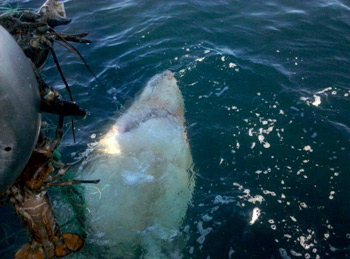Mass Lobstermen Question
Gillnet Lobster Take
by FV Staff

Great white shark and two lobsters in a gill net off Massachusetts.
Lobstermen on outer Cape Cod, Massachusetts, would like to see changes to Massachusetts fisheries law that allow lobster to be taken with gill nets. The state law views lobster as bycatch in gillnets and currently allows gillnet fishermen to take up to 100 lobsters in a 24-hour period with a maximum of 500 lobster in five days.
An outer Cape lobsterman said this has been an issue for a number of years. The Cape Cod Commercial Hook Fishermen’s Association confirmed this fact.
Gillnets are ordinarily set with one edge a weighted lead sink line and the opposite edge a float line. This creates a wall of fine monofilament line mesh that fish don’t see, swim through and are snared by their gills.
Beyond the issue of bycatch, the trap lobster fisherman said some gill netters are setting nets in a way that targets lobster and is referred to as a tie-down net. He said by tying the floatline edge to the sink line the net lays near or on the bottom catching fish that are left there as bait for lobster.
As by-catch, there is no Massachusetts Department of Marine Fisheries (DMF) regulation regarding size or egg-bearing females.
Trap lobstermen are subject to a range of regulations covering carapace size, egg-bearing females, number of traps fished, and seasonal closures. But gillnetters are not subject to any of these lobster regulations under current law. A fact, the lobsterman said, “that is not only unfair, it is not in the best interests of the health of the resource, which is why there are regulations in the first place.”
Four years ago, lobstermen brought the issue to the Massachusetts DMF. That resulted in a decrease in the number of lobster gillnetters were allowed to take. But lobstermen continue to object what they describe as a directed lobster fishery with gill nets.
Gillnet fishermen are required to have a federal non-trap permit. To land lobster in Massachusetts they also need a state non-trap permit. In 2010 there were 244 offshore non-trap permits issued. Massachusetts has changed from an annual catch report requirement to trip level reports beginning in 2008 which gill netters are required to submit monthly. Reports in pounds of lobster to the DMF (Not dealer data) were: 2007 - 123,931; 2008 – 178,762; 2009- 142,755
Massachusetts lobster regulations are different in many ways from Maine’s. There are several different licenses available for taking lobster. Massachusetts law also allows draggers to land lobster, also considered bycatch. This has resulted in draggers from states other than Massachusetts landing dragged lobster in Massachusetts.
Peter Shelly of the Conservation Law Foundation (CLF) said the problem lobstermen have with gill netting lobster has surfaced periodically for years without resolution. He described gill netting as not being a clean fishery. But, he said, Massachusetts lobstermen “don’t have as much clout as Maine lobstermen.”
